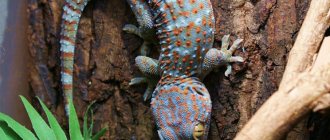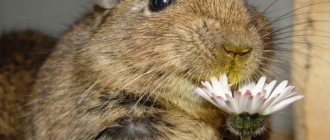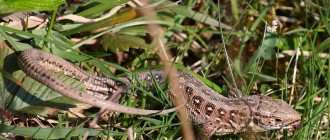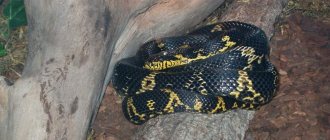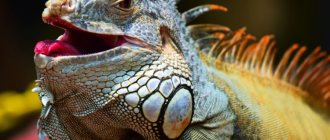- Exotic pets
The exotic iguana lizard looks impressive and beautiful, especially for our cold latitudes, but the desire to acquire such a pet often ends at the planning stage of arranging conditions for the reptile. Many people are concerned about how to care for an iguana at home, because this animal is accustomed to the hot and humid climate of Central and South America. Moreover, the question of a specific diet also remains open, since providing proper nutrition to a tropical lizard is not so simple, and the question of what to feed an iguana at home is quite acute. In this article we will try to answer most of the questions about this animal, as well as help you choose a healthy iguana as a pet.
How to choose an iguana?
First of all, you need to remember that iguanas are only born in May and June. For this reason, if you want to become the owner of a 2-month-old pet, it is best to go to the store at the end of summer. You cannot count on the fact that a 2-month-old iguana can appear in January, since this is contrary to natural laws.
Sellers cannot correctly determine the gender of a pet. A domestic iguana will certainly delight you with its presence, but it is advisable to understand that the correct sex will only be determined during puberty of the pet, so you will have to wait another year and a half for this wonderful moment. Professionals can answer the question regarding gender at 7–8 months by conducting special tests, but the answer cannot be provided earlier.
So, what is the best way to choose an iguana to ensure a worthy purchase?
- It is imperative to examine your pet's mouth. It is best to take the fry with your right hand, and then slightly pull the edge of the throat fold with your left hand. A light pink mouth will indicate good health, and the tongue should be reddish. Warning is caused by a very light or grayish-lilac tint of the oral cavity, since such changes indicate a lack of calcium that needs to be replenished. Other colors indicate serious illness.
- It is mandatory to carefully examine the limbs and fingers, which cannot be swollen or swollen. Lack of claws is remediable, as claws can gradually grow back if there is no serious damage.
- It is recommended to carefully examine the skin of the fry to make sure there are no spots or spots indicating the presence of a serious disease.
- Inspection of the comb and the tip of the tail is a mandatory step. Dark color or dryness is undesirable. However, your pet's comb and tail tip can be improved with proper care.
- It is recommended to have stool tested to ensure that the iguana is free of helminths or to find out about their presence. Getting tested is an important task not only for the pet, but also for its owner.
Size and lifespan
Large lizards can reach a maximum size of 1.5 meters in length and weigh more than 9 kg. Moreover, males are larger than females, which rarely reach a size of 130 cm. Also, a sexually mature male green iguana has a larger crest on his back.
With good care, a domestic green iguana can live 15 to 20 years in captivity.
Maintenance and care
Keeping an iguana is quite difficult if you live in an ordinary apartment. A terrarium with a volume of 200 liters is enough for a baby or teenager up to 45 cm long.
However, this volume is enough for acclimatization, since if you immediately put the baby in a huge terrarium, it will not be easy for him to find food and water.
It is also easier to tame a lizard, so a small terrarium at the initial stage is better than a spacious one.
But an adult green iguana needs a VERY spacious terrarium.
This graceful baby will grow very quickly and can grow into a 1.5 meter dinosaur, which an ordinary fan simply has nowhere to keep.
An adult green iguana does not need a terrarium, but an enclosure. At least 3.5 meters long, 1.8 wide and high. The height of 1.8 meters is very important, since in nature they mainly live in trees.
A simple rule: the enclosure must be at least twice as long as the individual, and the width must be no less than its length. In addition, do not forget that you cannot keep two males in the same enclosure, otherwise they will fight.
Iguana food
Feeding an iguana is not that complicated; it is important to correctly calculate the amount of food the animal needs. This “small” lizard is a real vegetarian who eats nothing but grass and vegetation. By the way, it is this factor that is decisive when choosing between an iguana and a chameleon, which, in fact, is also a relative of lizards. In the wild, it eats young leaves of fruits and flowers, but at home it can be fed with other foods. You can give your green dragon fruits, cut vegetables, and lettuce. She will certainly be happy about this, but until she is 1 year old, you can give her a small amount of protein, then she will grow much faster. This may be chicken meat, or canned dog food, but, I repeat once again, protein should be given in small quantities, and only up to one year. You should not give citrus fruits such as tangerines, oranges, grapefruit. However, you can give the leaves of these fruits if you have access to them. In the spring you can give her cat grass. This is such a thin green grass that grows in every yard; cats eat it to cleanse the body of toxins. The iguana also loves this grass. If you don’t want to take risks and don’t want to feed your miracle animal anything, then zoological stores sell special food for iguanas, although, I repeat, it can eat cabbage, lettuce, and apple leaves after you.
She should be fed several times a day, usually twice. It may be that the iguana does not accept a certain product, then you should replace it with another, and no longer give it what it did not want to eat. If the iguana is hungry, it may attack you, so do not let it go hungry, otherwise your hands will get bitten. Also, do not scare her, she may attack. But, despite this, the iguana is a rather peaceful animal that has already adapted to such living conditions.
Origin of the species and description
Photo: Iguana
This species was first formally described by the Swedish botanist Carl Linnaeus in 1758. Over the two centuries since then, many subspecies have been identified, but later, after genetic studies, they were classified as simple regional variants of the same species, except for the Caribbean iguana.
Video: Iguana
Using nuclear and mitochondrial DNA sequence data to study the phylogenetic history of the iguana, the scientists studied animals collected from 17 different countries. Topology of the phylogeny showed that the species originated in South America and eventually moved through Central America and the Caribbean. The study did not identify unique mitochondrial DNA haplotypes for subspecies status, but indicated deep lineage divergence between Central and South American populations.
There are two subspecies of the common iguana:
- iguana iguana iguana is distributed in the Lesser Antilles and South America;
- iguana iguana rhinolopha - This form is native primarily to Central America.
Both taxa can be fairly safely distinguished by the two or three small “horns” present on the face of iguana rhinolopha. The word "iguana" comes from the Spanish form of the name in the language of the Taíno people, who lived in the Caribbean before the arrival of the conquistadors and sounded like "iwana". Over time, the Spanish version of the name became the scientific name of this species. In some Spanish-speaking countries, males of the species are called gorrobo or ministero, while juveniles are called iguanita or gorrobito.
Important aspects of caring for an iguana
To ensure the maintenance of this lizard at home, it is necessary to create special conditions. Terrarium. The conditions in it should be as close to natural as possible. Temperature is 28-30°C during the day and 22°C at night. Humidity level is about 80%. Lighting. The iguana needs a sufficient amount of ultraviolet light. The change of day and night is also very important for this animal. Provide approximately 12-14 hours of light and 10-12 hours of darkness every day. Feeding. The diet for an iguana is approximately as follows: 30-70% of the diet is leafy plants and vegetables, 5-15% is fruits and up to 10% is additional products, for example, grain complexes. Please note that it is strictly forbidden to feed your lizard with leftovers from your table - this can have a detrimental effect on its health. Bathing. You can and should bathe your iguana. The optimal water temperature is 30-35°C. Twice a week is enough, but more often during shedding season. Appeal. Due to the obstinate nature of iguanas, they must be handled very carefully. Take her from above near the forearm, with the other hand pressing her hind legs to her body. But it’s better not to touch the tail - she can throw it off, and then it will be much more difficult for her to keep her balance and climb the branches. When releasing the iguana from the terrarium, make sure that it does not disappear from view for a long time. By providing the iguana with appropriate care and attention, you will receive not only an exotic animal, but also a devoted friend in the person of your beloved pet.
Interesting Facts
Terrarium: size, arrangement, temperature, humidity
- Cat claw attachments
- Dog
- Long-eared cats
- Cat meowing
- Alexandrian parrot
- Why does a cat need a mustache?
At home, the iguana is kept in a terrarium. You can take it out from there for communication, swimming, walking, but its main place of residence is the terrarium.
It is in it that it will be possible to maintain the necessary temperature and humidity for the iguana; under normal room conditions the animal will not survive. The iguana grows up to 1.5-2 meters in length, so the “house” must correspond to its size, and it must move around it calmly.
In addition, the terrarium should have three areas with different temperatures: in one corner (side) there is a place where the lizard warms itself, where the temperature should be about 30 degrees. Usually, a branch or snag is placed for the iguana, along which it climbs to the lamps and warms itself there - the first thermometer should be placed in this area. Heating is regulated by the power of the lamps; very powerful lamps that heat up during operation must be covered with a metal mesh to prevent the lizard from getting burns. Regular lamps can be used, but it is better to use UV lamps.
The second thermometer is placed in the same warm area, but at the bottom or diagonally from the lamp; it should show an average temperature of 26-27 degrees. And the third is placed in the farthest cool corner - there should be at least 25 degrees.
A quarter of the area should be given over to a pond - the lizard can drink from it, and it also maintains the required humidity..
The bottom is lined with a mat, paper napkins are placed on top, and a thick, large bark is placed on them. The napkins are replaced daily, the mat and bark are washed with warm water. The water bowl is cleaned twice a week, and once a month the terrarium is thoroughly cleaned and disinfected. The iguana does not tolerate a lack of water well, so along with a swimming pool, it is wise to put a regular drinking bowl in the terrarium and change the water in it every day.
Lighting and heating
They need a very warm climate and the same conditions need to be recreated at home. For juveniles, one heating llama is enough, but for adult iguanas, there are at least six llamas so that it can warm its entire body.
In addition, UV lamps should be used in conjunction with heating lamps.
Ultraviolet lighting is necessary for the lizard to produce vitamin D and absorb calcium.
Otherwise, it will lead to diseases and deformation of the skeleton. The Repti Glo 5.0 lamp from Exo-Terra works well.
There should be a heating point in the enclosure, with a temperature of at least 40°C. The heat source should be located above the iguana, this will help it regulate its body temperature.
The fact is that the iguana has a “third eye” organ on the top of its head, behind the eyes, which is responsible for controlling movement, changes in light and darkness.
It is needed for two purposes - to respond to danger (from above, birds of prey) and to regulate body temperature.
Of course, part of the enclosure should be cool so that she can choose places with higher and lower temperatures herself.
A warm corner with a temperature of about 40°C and a cool corner with a temperature of 27°C.
It is very important that she can regulate her body temperature herself by moving between these places. And given its size, the terrarium must be appropriate.
Do not use any heating sources that heat from below. This could include rugs, stones and heated decor.
The fact is that she does not recognize them as a heating point, and gets overheated and burns. The paws and stomach are especially affected, leading to the death of the lizard.
Taming
How to tame an animal like an iguana? At home, this reptile will be happy to frequently communicate with its owner. Contact with the pet involves feeding and bathing. To teach an animal to trust a person, you need to regularly hold him on your arms and shoulders. Keeping an iguana requires devoting a significant amount of time to it, so before getting such a pet, you should adequately weigh your options. Veterinarians warn: despite the fact that an iguana at home quickly gets used to a person, it can bite. Therefore, care should be taken when handling it and, if possible, wear leather gloves.
Feeding
Green iguanas are exclusively herbivores; in nature, they eat vegetation and tree fruits.
At home, they eat dandelions, zucchini, cucumbers, turnips, cabbage, and lettuce. Fruits can be given no more than once a week, as heavy feeding causes diarrhea.
Preparing food for small iguanas is a little different than feeding adults. When you cut food, you need to chop it into pieces that they can swallow without problems.
Remember that they do not chew their food, but swallow it whole.
In addition to plant foods, you can also feed commercial ones, which provide the lizards with everything they need. Their disadvantage is the price, whatever one may say, and ordinary greens are cheaper.
Be sure to give calcium supplements about once a week. And under no circumstances should you feed protein foods! This will lead to the death of the lizard.
Breeding iguanas at home
In the most common green iguanas, sexual maturity occurs in the fourth year of life, and the appropriate time for breeding is winter. The place where mating will take place is chosen by the males, who mark it with a special secretion that is released from their paws.
- During the courtship period, males become brighter and bloated, and they also show affection towards their partner by biting her neck.
- A green iguana at home will walk pregnant for two months. The female buries the clutch in the ground, and it includes from 20 to 70 eggs.
- The young will appear in about 4 months. The offspring do not require care from their parents, since lizards have a gall sac with reserves of nutrients that are enough for the first time.
Social structure and reproduction
Photo: Baby iguana
Most common iguanas reach sexual maturity at 3–4 years of age, although maturity can be reached earlier. They breed during the dry season, allowing their offspring to hatch during the rainy season when food is more available. Courtship occurs in a specific territory where more than one female may be present. Conflicts between males are not uncommon. Dominant males mark rocks, branches and females with a special substance containing a waxy pheromone secreted from their femoral pores.
During mating, the male climbs onto the female's back. To hold the female, he grabs the skin of her shoulder with his teeth, even causing injuries. The male then connects his cloacal opening to the female and inserts one of his hemipenes into her cloaca. Copulation can last several minutes. Females can store sperm for several years, allowing them to fertilize eggs much later. Approximately 65 days after mating, the female begins to lay eggs. The size and number of eggs varies depending on her size, diet and age. The eggs have a diameter of about 15.4 mm and a length of 35 to 40 mm.
Over a three-day period, an average of 10 to 30 leathery, white or pale cream-colored eggs are placed in the nest. The nests are located at a depth of 45 cm to a meter and can lie together with the eggs of other females if the nesting area is limited. After laying eggs, females may return to the nest several times, but do not remain to guard it. Incubation lasts from 91 to 120 days. The temperature should be between 29 and 32 °C. The chicks crack open the egg using a special tooth that falls out shortly after hatching.
Fun fact: After hatching, young iguanas look similar to adults in color and shape. They resemble adult females rather than males and lack dorsal spines. As these animals age, there are no major morphological changes, except that they grow.
However, an animal's diet is directly related to age. Young iguanas have a higher protein requirement and consume insects and eggs more often than mature individuals. Offspring remain in family groups for the first year of life. Male iguanas in these groups often use their own bodies to defend themselves and protect females from predators, and they appear to be the only reptile species to do this.
How to choose a healthy lizard at a pet store
To choose a healthy lizard in a store or from private sellers, you need to pay attention to important points:
- A normal animal will not fall into the hands of a person; it will resist, run away and nervously lash its tail. If a lizard is sluggish and inactive, this does not mean that it is brave or tame. Most likely she is sick.
- The eyes should be clear and bright.
- The anus is normally clean, without traces of dried feces.
- The nose and mouth should be free of sticky mucus.
- The skin of a healthy young animal is bright green.
- The iguana has an excellent appetite. You can ask the owner to show her how she eats.
Iguana Temperament and Behavior
It is very important to handle your iguana with care and patience. Although these reptiles can live near humans, they will never truly become pets, and many of them try to escape not only from their enclosures, but even from their homes. Young iguanas need to be handled regularly for taming purposes so that they learn to trust their owner and feel comfortable in human hands. However, domestication can often be a problem because reptiles do not come naturally to such contact with humans and may resist it.
Baby iguanas can move quite quickly, but adult lizards often become quite lazy and slow (at least when they don't feel threatened). When released from their cage, some iguanas can climb on top of their owners. Therefore, owners of such iguanas should wear protective clothing to protect themselves from very sharp claws.
Iguanas prefer a predictable routine that makes them feel safe. However, they have a strong self-defense instinct and will bite, scratch and lash their tail if they feel threatened. An iguana can actually cause real damage with tail strikes, as an adult reptile's tail is strong enough to break a human bone. Therefore, you should pay attention to the slightest manifestations of aggression when handling them, especially if there are children or other pets nearby.
When an iguana reaches sexual maturity, its behavior changes and it usually becomes a little more aggressive, especially during the breeding season. This stage lasts until the iguana is about five years old. Then it stops growing and enters the stage of a mature adult.
Important! Like most reptiles, iguanas carry salmonella without suffering from it themselves. However, people can become infected by touching the iguana or objects in the terrarium. Therefore, follow the rules of hygiene when handling these animals. Wash your hands thoroughly before and after handling your pet and do not touch your face without washing your hands.
Green iguana does not eat meat
Handling the iguana
Many iguanas have a restive and even obstinate character; you need to take such pets from above near the forearm, clasping the body so that the reptile's front legs are pressed to the body. With your other hand, press the hind legs to the body, but do not touch the tail. You can handle the iguana with gloves to avoid being scratched by its claws.
An iguana should not be grabbed by the tail; the reptile may throw it away. Of course, the iguana will not die, but it will be very difficult for it to maintain balance and climb branches. In adults, a new tail may never grow; in children, this process often happens faster. Do not squeeze the reptile, as this may cause the cloaca to prolapse, then no one except a qualified veterinarian will help the animal. When removing the iguana from the branches, do it carefully, smoothly, do not tear it off with force, otherwise you may damage your pet’s fingers and paws.
Video
Characteristics of the reptile
Iguanas are particularly large lizards. The length of the largest individuals can reach one and a half meters. The reptile feeds on plants and lives in tropical parts of America. Their distinctive feature is a large and laterally flattened tail, the length of which is 2 times the length of the body. Adult animals weigh little. The body weight of a male is no more than 4 kg, and that of a female is 3 kg.
The body of the iguana is quite thin, it is covered with transverse rows of scales. Its upper part has a longitudinal ridge. The reptile's throat is decorated with a leather bag. Its paws are short, and its fingers have huge claws that help the animal climb trees without hindrance.
The bright green color helps the iguana hide in the rainforest. There are also individuals whose color varies from purple and reddish to blue. The color of the body is associated with the habitat and age of the reptile.
The lizard has good eyesight, so it is able to see objects at a great distance. It can detect ultraviolet rays, which helps control the amount of vitamin D. At night, the iguana has difficulty distinguishing objects. Her auditory organs are also well developed. Even the slightest rustle of grass will not go unnoticed. The animal's teeth are sharp, the jaw is equipped with small fangs along the edges.
Creatures belonging to the iguana family differ from other species in their ability to carry out salt exchange with the outside world. In such animals, urine does not accumulate in the body. Excess salts are released through special salt glands. They are located on the head and look like crystalline powder.
